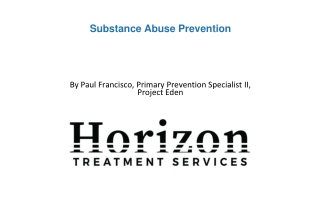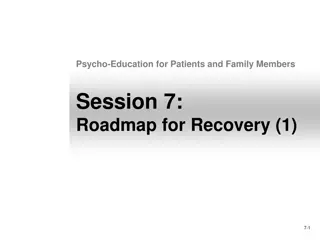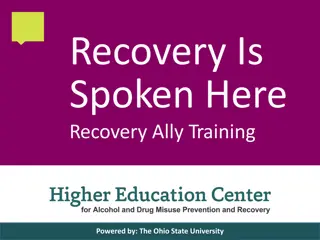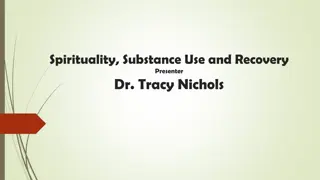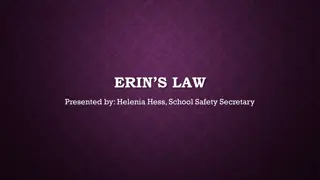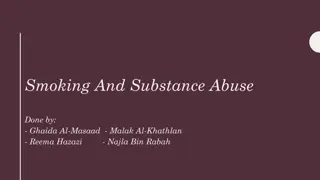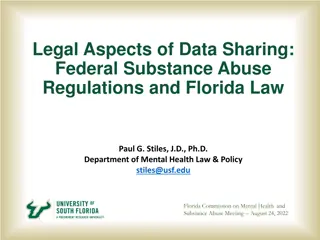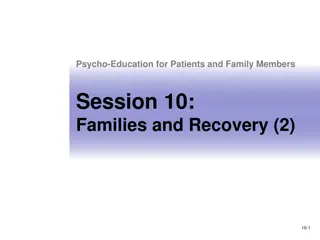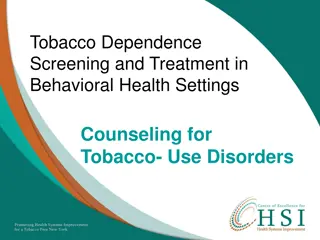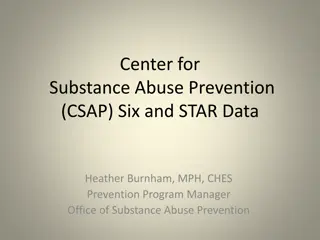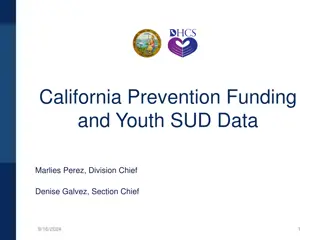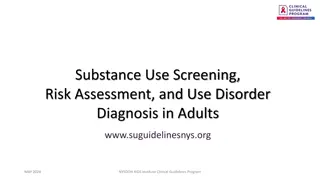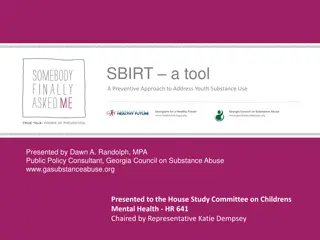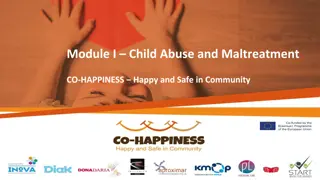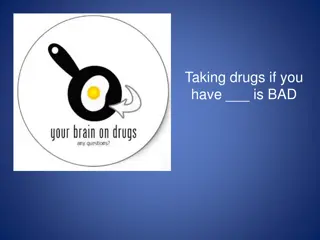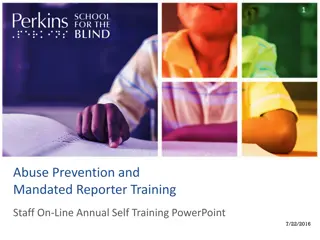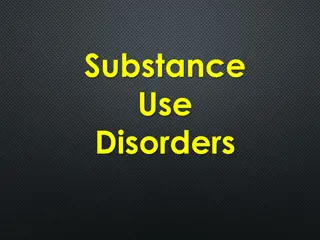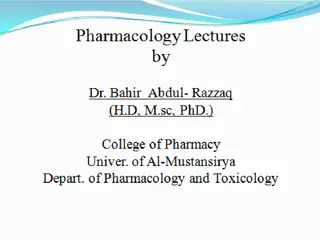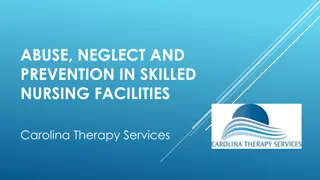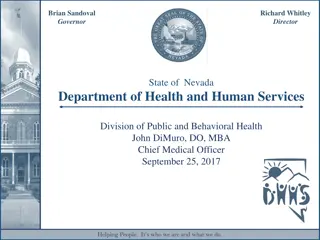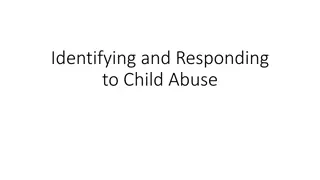Understanding Relapse Prevention in Substance Abuse Recovery
Relapse prevention in substance abuse recovery focuses on teaching individuals to recognize and manage warning signs leading to relapse. It involves identifying triggers, changing thought patterns, and establishing a strong support system to maintain sobriety. By addressing bio/psycho/social aspects and practicing strategies to cope with distress effectively, individuals can prevent relapse and progress through the stages of recovery successfully.
Download Presentation

Please find below an Image/Link to download the presentation.
The content on the website is provided AS IS for your information and personal use only. It may not be sold, licensed, or shared on other websites without obtaining consent from the author. Download presentation by click this link. If you encounter any issues during the download, it is possible that the publisher has removed the file from their server.
E N D
Presentation Transcript
Relapse Prevention: 101 CHRISTY HICKS, CSW/LCADC
What is Relapse Prevention? A method of teaching recovering students to recognize and manage relapse warning signs. Becomes a primary focus for students who are unable to maintain abstinence from alcohol or drugs despite primary treatment.
Discussion What Relapse Prevention measures do you take on your center? Type your responses in the Chat Box for discussion.
PRH Page 6-11, R1 Centers shall provide basic TEAP services, as described below: The general emphasis of TEAP shall be on prevention, education, identification of substance use problems, relapse prevention, and helping students overcome barriers to employment.
Relapse Relapse episodes are usually preceded by a series of observable warning signs. Typically, relapse progresses from bio/psycho/social stability through a period of progressively increasing distress that leads to physical and emotional collapse. The symptoms intensify unless the individual turns to use alcohol or drugs for relief.
Recovery and Relapse Recovery and Relapse can be described as a related process that unfolds in 6 stages: Abstaining from alcohol and other drugs. Separating from people, places, and things that promote the use of alcohol or drugs, and establishing a social network that supports recovery. Stopping self-defeating behaviors that prevent awareness of painful feelings and irrational thoughts. 1. 2. 3.
Recovery and Relapse, cont. Learning how to mange feelings and emotions responsibly without resorting to compulsive behavior or the use of alcohol and drugs. Learning to change addictive thinking patterns that create painful feelings and self-defeating behaviors. Identifying and changing mistaken core beliefs about oneself, others, and the world that promote irrational thinking. 4. 5. 6.
How to Recognize Relapse When a student who has been stable and done well in recovery begins to relapse, he/she reverses the recovery process. In other words, those who relapse: Have a mistaken belief that causes irrational thoughts. Begin to return to addictive thinking patterns that cause painful feelings. Engage in compulsive, self-defeating behaviors as a way to avoid feelings. Seek out situations involving people who use alcohol and drugs. Find themselves in more pain, thinking less rationally, and behaving less responsibly. Find themselves in a situation in which drug or alcohol use seems like a logical escape from their pain, and they use alcohol or drugs.
9 Principles of Recovery Self-Regulation Integration Understanding Self-Knowledge Coping Skills Change Awareness Significant Others Maintenance 1. 2. 3. 4. 5. 6. 7. 8. 9.
Principle 1: Self-Regulation The risk of relapse will decrease as a student s capacity to self-regulate thinking, feeling, memory, judgment, and behavior increases.
Stabilization Detox from alcohol and other drugs Solving the immediate crises that threaten sobriety Learning skills to identify and manage Post Acute Withdrawal and Addictive Preoccupation Establishing a daily structure that includes proper diet, exercise, stress management, and regular contact with treatment personnel and self-help group
Principle 2: Integration The risk of relapse will decrease as the level of conscious understanding and acceptance of situations and events that have led to past relapses increases.
Self-Assessment History of alcohol and drug use Reconstruction of the presenting problem (why) Assessment of needs
Principle 3: Understanding The risk of relapse will decrease as the understanding of the general factors that cause relapse increases.
Relapse Education Reading assignments Writing assignments Warning sign identification Complicating factors in relapse Relapse warning sign management strategies Effective recovery planning All should be tailored to specifically to fit your individual students
Principle 4: Self-Knowledge The risk of relapse will decrease as the patient s ability to recognize personal relapse warning signs increases.
Warning Sign Identification Develop a personal relapse warning sign list to identify the sequence of problems that has led from stable recovery to alcohol and drug use in the past and how those shape relapse in the future.
Principle 5: Coping Skills The risk of relapse will decrease as the ability to manage relapse warning signs increases.
Warning Sign Management This involves teaching students how to mange or cope with their warning signs as they occur. The better they are at coping with warning signs, the better their ability will be to stay in recovery. Warning signs can be: Situational and behavioral Thoughts and feelings level Core issues
Principle 6: Change The risk of relapse will decrease as the relationship between relapse warning signs and recovery program recommendations increase.
Recovery Planning Each specific warning sign should be linked to a specific recovery activity or person.
Principle 7: Awareness The risk of relapse will decrease as the use of daily inventory techniques designed to identify relapse warning signs increase.
Inventory Training Complete daily inventory Identify daily goals Monitor program compliance Creation of a to-do list Review the list both morning and night to make sure you are on track Whenever possible, these inventories should be reviewed by someone who knows the student and who can assist him/her in looking for emergency patterns or problems
Principle 8: Significant Others The risk of relapse will decrease as the responsibility involvement of significant others in recovery and in relapse prevention planning increases.
Involvement of Others We can not recover alone, you need the help of others. Family members Program sponsors Counselors Peers Churches
Principle 9: Maintenance The risk of relapse decreases if the relapse prevention plan is regularly updated during the first 3 years of sobriety.
Relapse Prevention Planning and Updating A relapse prevention plan update session involves the following: A review of the original assessment, warning sign list, management strategies, and recovery plan. An update of the assessment by adding documents that are significant to progress or problems since the previous update.
Relapse Prevention Planning and Updating, con t. A revision of the relapse warning sign list is to incorporate new warning signs that have developed since the previous update. The development of management strategies for the newly identified warning signs. A revision of the recovery program to add recovery activities to address the new warning signs and to eliminate activities that are no longer needed.
The Relapse Prevention Plan Here are some ideas for what to include in your plan: Triggers 1. People, places and things that trigger cravings How to avoid triggers How to manage high risk situations that cannot be avoided Managing Cravings 2. Relapse Emotional Mental Physical
The Relapse Prevention Plan, cont. Useful Tools 3. Gratitude list Relaxation techniques Stress management techniques Support People to call when you have cravings or stress Mental and physical wellness Recovery Program 12 Step work Moral inventory/character defects 4. Ways to make amends
The Relapse Prevention Plan, cont. 5. Life Improvement Finances Family relationships Housing Spousal/significant other relationship Basic needs Support/friends Mental health Legal issues Spirituality School Purpose Employment
Basic Relapse Prevention Techniques Centering Relaxation Technique Put both feet on the floor, sit up straight and close your eyes. Breathe in through your nose and out through your mouth. Breathe in deeply, hold it for a second, then breathe out. Do this again and feel your lungs fill with air, then empty. Slow your breathing to a steady rhythm. See if any thoughts are entering your mind. Ask yourself if you are feeling any body tensions. Open your eyes when you are ready. Speak slowly as you give the instructions. This will help the student calm down.
Sentence Completion Technique used to help students identify thoughts that they have that may not be true, mistaken beliefs. Have the student form a sentence stem: I know my recovery is in trouble when When I think about drugs, I . Right now, I am feeling .. Repeat the different endings with each student. Repeat them all several times. You may want them to even write it down. Look for common themes. You can use the common endings to start another stem.
Sentence Repetition Sentence repetition is a way for students to become conscious of mistaken beliefs and the thoughts, feelings, and actions they cause: If I continue to believe this, the best that can happen is the worst that can happen is the most likely to happen is If I change what I believe, the best that can happen is the worst that can happen is the most likely to happen is
Mistaken Belief I can t tell others what I feel or they will look down on me.
Adolescent Risk Adolescents are at higher risk for relapse due to their developmental stage. Chemical dependency may have delayed normal development, making it difficult for them to function in an appropriate way.
Adolescent Risk Learning disabilities Dual or multiple diagnosis High stress personalities Inadequate coping skills Lack of a support system Dysfunctional families Lack of impulse control Divorce or separation of parents Moving away from old friends, changing schools Loss or death of family members Breakup of relationship with boyfriend or girlfriend
Relapse Related to Job Corps Relapse Prevention is a core component of an effective TEAP. Those students who are identified as high risk early on through the assessment phase need to have a clearly defined relapse prevention plan (copy in the SHR).
Relapse Related to Job Corps, cont The plan should be a road map to help Peer mentoring Check-ins with the TEAP Specialist Recreation involvement Attendance at self-help groups Help with finding new ways to structure their leisure time through recreation, leisure time activities, and other wellness activities Have students set specific goals and visions Understanding of the relapse process Identify high-risk situations and how to deal with them
Relapse Prevention on Job Corps Centers Relapse Prevention programing on center is not just relapse groups, plans and NA meetings. Its an all inclusive program, including: CHORES AND USEFUL TASKS (such as Cleaning, Cooking, Dishwashing, Ironing, Sewing). EXERCISE (such as Jogging, Nautilus, Walking, Aerobic Dancing, Stretching or Aerobic Exercises, Shadow Boxing, Skipping Rope, Yoga, Weightlifting). FOOD ACTIVITIES (such as Baking, Cooking, Barbecuing, Preparing Gourmet Meals, Shopping for Food). GAMES (such as Bridge, Checkers, Chess, Go, Jigsaw Puzzles, Monopoly, Poker, Pinochle, Scrabble, Crosswords, Anagrams). GRAPHIC ARTS (such as Cartooning, Drawing, Lettering, Mechanical Drawing, Painting, Photography, Silk screening).
Relapse Prevention on Job Corps Centers, con t. HANDICRAFT ACTIVITIES (such as Basket making, Bookbinding, Crocheting, Embroidering, Knitting, Leatherworking, Dressmaking, Decoupage, Needlepoint). HUMOROUS ACTIVITIES (such as Cartooning, Improvisation Games, Charades, Jesting, Joke-making, Playing Practical Pranks and Jokes, Punning). MARTIAL ARTS (Akido, Jujitsu, Judo, Karate, Fencing, Wrestling). OUTDOORS ACTIVITIES AND SPORTS (such as Birdwatching, Gardening, Crabbing, Fishing, Canoeing, Sailing, Hunting, Walking, Ice-skating, Skiing, Rowing, Hiking). PERFORMING ARTS (such as Dancing, Ballet, Mime, Acting, Improvisation, Modern Dance, Tap Dance, Singing). PERSONAL GROWTH (Self-help Books, Workshops, Lectures, Skills-learning, Career Development). READING (Fiction, Novels, Plays, Poems, Nonfiction).
Relapse Prevention on Job Corps Centers, con t. SCIENTIFIC ACTIVITIES (such as Anatomy, Biology, Herpetology, Physics, Medicine, Zoology, Anthropology, Psychology, Sociology). SOCIALIZING ACTIVITIES (such as Conversing, Group Activities, Attending or Giving Parties, Rap Sessions). SPECTATING (watching Movies, Plays, Sports, Pageants, Circuses). SPORTS (such as Baseball, Basketball, Golf, Gym, Football, Hockey, Dancing, Tennis, Skating, Running, Volleyball). STUDYING ACADEMIC SUBJECTS (such as Art History, History, Language, Math, Music, Science, Social Science). TRADES AND CRAFTS (such as Bricklayer, Builder, Carpenter, Foreman, Factory Worker, Gardener, Mechanic, Machinist, Police Officer). VENTING FEELINGS (such as Punching Pillows, Yelling, Talking, Writing, Expressing Good Feelings).
Relapse Prevention Game The Relapse Prevention Game by Berthold Berg, Ph.D. Here is a cognitive-behavioral relapse prevention program for adolescents and adults recovering from alcohol and drug abuse. The game systematically prepares them to deal with the many threats to sobriety by identifying subconscious urges to use and countering them with conscious and rational arguments. By playing the game, individuals acquire the cognitive and behavioral skills necessary to sustain abstinence. A self-report inventory is included to help identify individual needs. Professional counselors can use this game with individuals or groups of up to 6 players. Because it requires minimal training, this game is also excellent for self- help groups. It can serve as the core of a cognitive recovery group, an adjunct to Alcoholics Anonymous, or an alternative for those who don't benefit from the AA approach to recovery. The structured format helps groups stay on task, and game cards assure that discussions touch on a wide range of issues. The game can be played with adolescents, who will enjoy its chance elements, or with adults, who may prefer to forego game play in favor of concentrating on the game cards.


